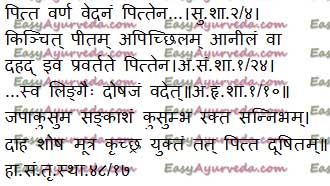Menstrual Disorders Caused By Pitta Vitiation – Pittaja Artava Dushti
By Dr Raghuram Y.S. MD (Ay) & Dr Manasa, B.A.M.S
Pittaja Artava Dushti is one among the 8 types of menstrual disorders mentioned in Ayurveda. This is caused by predominant vitiation of pitta dosha. It is also called as Pittaja Artava Vyapad.
Read – Artava – Menstrual Blood Formation, Healthy Characteristic Features
Table of Contents
Signs, symptoms
Signs and Symptoms of Pittaja Menstrual Disorders
Pitta Varna –
Menstrual blood which is vitiated and contaminated by pitta is discharged in different colours particular to pitta. Blood is yellowish or bluish in colour.
Pitta Vedana –
Woman suffers from various kinds of pain which are typically caused by vitiated pitta. She may experience sucking pain, burning pain etc.
Read – Menstrual Pain, Painful Periods – Natural Ayurvedic Herbal Home Remedies
Other symptoms –
- Kinchit peeta artavam – menstrual blood is light yellow in colour
- Kinchit neela artavam – menstrual blood is light blue in colour
- Apichchilam artavam – menstrual blood is devoid of stickiness / unctuousness
- Dahat iva pravartate – menstrual blood is associated with severe burning sensation and feeling of heat being eliminated, at the time of excretion
- Ushnata – menstrual blood is hot while getting discharged
- Visra gandha – smells like pus, fungus, blood or has putrid smell
- Japa kusuma sannibham – colour of the discharged menstrual blood resembles that of hibiscus flower
- Kusumbha sannibham – colour of discharged menstrual blood resembles safflower in colour
- Rakta varna sannibham – has the color of blood
- Shosha – woman suffers from emaciation
- Mutrakrichra – woman also suffers from difficulty in urination, painful urination
Read – Ayurvedic Diet And Lifestyle During Menstruation (Periods)
Sanskrit verse

Treatment
Treatment of Pittaja Menstrual Disorder Controlling Pitta –
Following the principles of mitigating pitta, the below mentioned should be adequately used to combat pittaja menstrual disorder –
- Cold foods and comforts
- Consumption of foods rich in sweet and astringent tastes
- Intake of ghee / medicated ghee
Read – How To Balance Pitta Dosha? Line Of Treatment
Internal Medications –
Kakolyadi Kwatha
Decoction is prepared with kakoli (Roscoea procera), kshirakakoli (Lilium polyphyllum) and root of Pueraria tuberosa. This decoction is given to drink after adding sugar.
Read – Vidarikand Pueraria tuberosa Uses, Research, Side Effects
Utpaladi Kwatha
Decoction of utpala (water lily) and padhmaka (Prunus cerasoides) is prepared. This decoction is given to drink after adding sugar.
Read – Water Lily – Kumuda Benefits, Side Effects, Research
Madhookaadi Kwatha
Decoction of flowers of Madhuca longifolia and fruits of kashmari (Gmelina arborea) is prepared, added with sugar and served for drinking.
Read – Madhuca longifolia: Butter Tree: Uses, Remedies, Research, Side Effects
Chandana kwatha
Decoction of sandalwood is prepared and served for drinking after adding honey to the decoction.
Chandanadi Kalka
Paste prepared with powders of below mentioned herbs should be given mixed in milk added with sugar.
- Sandalwood
- Ushira – Vetiveria zizanioides (read more about ushira herb)
- Manjishta – Rubia cordifolia
- Pointed gourd – Tricosanthes dioica
- Ghana – Cyperus rotundus
- Balaka – Valeriana wallichii
- Liquorice
- Red variety of sandalwood
- Padhmaka – Prunus cerasoides
- Punarnava – both, white and red varieties of Boerhavia diffusa
- Sariva – Hemidesmus indicus
- Cumin seeds
- Krishna jiraka – Carum carvi
Read – Black Caraway Benefits, Usage, Dose, Side Effects – As Per Ayurveda
Madhukadi kalka
Paste of liquorice, Madhurasa (Marsdenia tenacissima) and raisins is mixed in ghee and given for drinking.
Dhavadi kalka
Paste of Dhava (Anogeissus latifolia) and flowers of Dhataki (Woodfordia fruticosa) is served for drinking mixed with ghee.
External therapies –
Gairikadi Kashaya yoni prakshalana
Vaginal irrigation should be done by using decoction prepared with gairika (red ochre) and neem. (Read about Neem plant)
Chandanadi kalka yoni dharana
Vagina should be filled with paste of sandalwood and payasya (Pueraria tuberosa).
Administration of purgation
Purgation to expel morbid pitta and also to cure pittaja menstrual disorder, Shamyaka (Cassia fistula) and latex of Gavakshi (Citrullus colocynthis) are given as purgatives.
Read – Virechana Therapy – Right Method, Side Effects, Management
Modern correlation
Modern Correlation and Comparative Study
Pittaja menstrual disorder is mainly caused by vitiated pitta. Excessive use of hot, corrosive and light food substances, exposure to excessive heat of sun or fire, excessive consumption of pungent, sour and salty foods and being angry etc causes will eventually vitiate pitta. This vitiated pitta will cause pittaja menstrual disorders.
Read – Gynecological Disorders Causes, Types As Per Ayurveda
Presence of bluish or yellowish colour in the menstrual blood is generally not seen in practice, therefore it is very difficult to explain this condition or correlate it with any condition based on these weird colours explained in treatises. We may infer that the presence of dry pieces of shed mucus membrane being expelled along with scanty bleeding may impart / give yellowish or bluish coloration to the menstrual blood.
Read – Charaka Chikitsa Sthana 30th Chapter – Yoni Vyapat
The other clinical features found in pittaja menstrual disorder i.e. presence of heat, burning sensation, putrid smell etc in the menstrual blood indicate infection of female reproductive system. They may eventually present in the form of menometrorrhagia or oligomenorrhea. On the contrary, pitta symptoms may be seen in these mentioned conditions.
Read – Pelvic Inflammatory Disease: Ayurvedic Treatment, Therapies, Medicines
Pittaja menstrual disorder can thus be correlated with ‘infection of reproductive organs’ or ‘chronic pelvic cellulitis’.
Click to Consult Dr Raghuram Y.S. MD (Ayu) – Email / Skype







